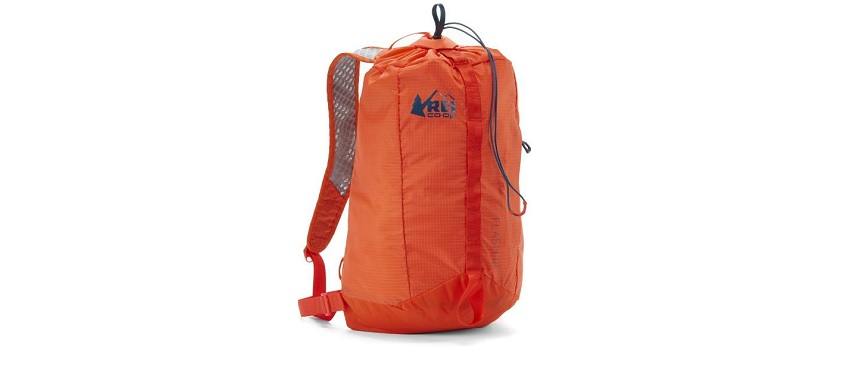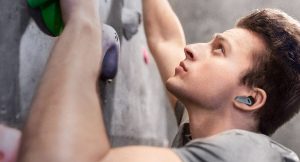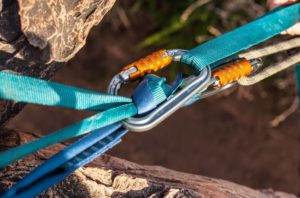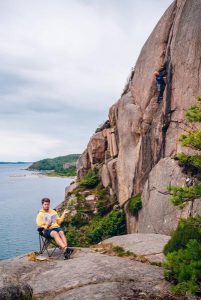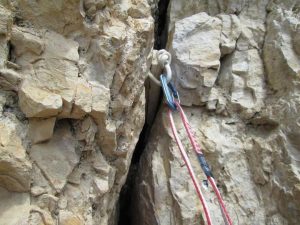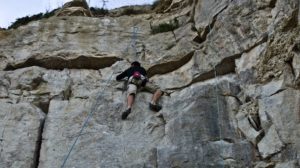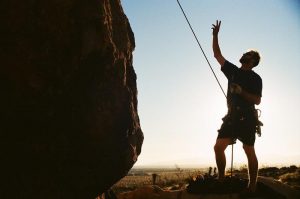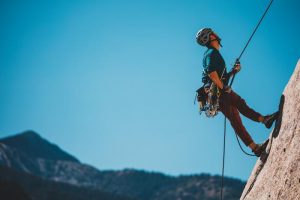We searched out seven of the best small climbing daypacks on the market and put them through extensive testing; these climbing backpacks went everywhere with us for over two months. From the high granite walls of Yosemite and Squamish to shorter trips up the Monkey’s Face at Smith Rock or the Bastille Crack at Eldorado Canyon, anytime we left the ground for more than one pitch at least one pack came along. These packs also did double duty by functioning as our hiking, mountain biking, bouldering daypacks as well as our around town bags (for trips to the grocery store or coffee shop). Our goal was to find the best all-around climbing daypack, one that was lightweight, durable, and that functioned well both on and off the rock.
Related: Best Rope Bags Review
Best Overall Rock Climbing Daypack: Patagonia Linked Pack 18L
- Light
- Stylish
- Comfortable
- Versatile
- Expensive
- No emergency whistle
This pack led from the beginning and never looked back. It is far and away our favorite climbing backpack and receives the first place score in three out of six evaluation criteria. We particularly like its low weight, functionality, comfort, and versatility. It is the only pack with legitimate haul loops and a sleek design with enough external carrying potential. Even its weaknesses were only slight. The durability of its 630-denier body is a concern but is bolstered by polyurethane and DWR coatings. Packed size is another category where it didn’t come in first, however, we can’t complain much about its compact shape or sleek exterior. Potential improvements include an emergency whistle and removable elastic cords for the attachment points on the sides. Nevertheless, the Patagonia Linked Pack 16L is still a huge improvement over previous options and we’re happy to pick as our best climbing backpack.
Best for Budget-Minded: REI Co-op Flash 18
- Light
- Cheap
- Ice axe loop
- Fragile
The latest version of this affordable pack is the REI Co-op Flash 18. The updates, which are covered fully in the individual review, include changes to the shoulder straps, a thicker, single daisy chain, and a new nylon carry handle/hauling loop. Overall, this pack remains similar to its predecessor, and without a price change, it’s still our budget pick.
The only pack in this selection not explicitly designed for rock climbing is the REI Co-op Flash 18. This could be one reason why it’s so much less expensive (for some reason gear marketed for life-threatening activities is always pricier). We chose to add the Flash to this review because it’s a popular choice among many climbers we know. The reasons why are simple: it’s light and cheap. For a lot of applications, it’s also equally functional compared to the higher-priced options. The Flash’s greatest weakness is durability. Its 140-denier nylon will get shredded rubbing over coarse rock. For 40 bucks, however, it won’t cost you too much to replace a bag destroyed by abrasion when climbing and hauling.
Also Great: Petzl Bug
- Durable
- Plenty of features
- Climbing oriented
The Petzl Bug is an exceptionally well-featured, well-designed backpack made specifically for multi-pitch climbing. It performs well on both the approach and the climb, and will easily hold all the essentials for a long day on the rock (or ice!). In our view, the Bug is the ideal followers’ pack and really shines when it is used in conjunction with another lighter, more minimalist pack for the leader, or when a single pack is shared between two climbers.
Choosing the Best Climbing Backpack for Your Needs
The selection of daypacks for climbing at your local gear store can be overwhelming at first glance. Here are some hints to try and make the experience a little less intimidating.
What we have done in this review is to weed out the majority of small backpacks on the market, first and foremost. Most are made primarily for hauling your laptop and are not very good for climbing. We ruled out any pack with a laptop sleeve (too heavy), as well as any pack with an external bungee or mesh pocket for stowing jackets, etc. These last two are great features on hiking packs but will get caught and torn when used on the rock. We also ruled out anything smaller than 12 liters (minimum size to still fit the essentials), and anything larger than 20L (larger packs will restrict your movement on the rock). It may be necessary for the follower to carry a larger pack on very long or cold climbs, but that is beyond the scope of this review.
When hunting for a backpack, start by asking yourself a few questions:
- How much am I willing to spend?
- Will I be using this pack primarily for rock climbing, hiking, mountain biking, or around-town?
- How long are the climbs I will generally be doing? 2-5 pitches? 10+ pitches?
- Will my climbing partner also have a daypack or will we be sharing mine?
- Which is more important to me, climbing-specific features or weight?
- Which is more important to me, durability or weight?
- Do I prefer to climb without a waistbelt?
- Am I looking more for a leader’s pack or a follower’s pack?
Leader’s pack vs. follower’s pack
We make this distinction because some packs will inhibit movement more than others. The ideal leader’s pack should be narrow, fitting primarily between the shoulder blades, and just big enough for the bare essentials. A follower’s pack may be slightly bigger to accommodate extra shared gear but should not be so big that it ruins the climbing experience for the follower.
Weight
The most cut and dry of the categories. When you’re fighting the good fight against gravity, it’s important to shave ounces wherever possible. The REI Flash 18 got top marks for being the lightest pack reviewed (10 oz), followed by the Cilo Gear 20L Worksack (11.6 oz). On the other side of the spectrum, the Mountain Hardwear Crimper weighed a whopping 24 oz.
Durability
An evaluation of general sturdiness. This includes the type and quality of materials used in the construction and our assessment of the pack’s ability to withstand repeated abuse. Factors that influenced a pack’s score were whether high-impact areas were reinforced and whether a certain aspect of the pack was less durable than the pack as a whole (mesh side pockets, for example, brought a pack’s score down). A big blow to a pack’s score came when a certain part of the pack was just inherently weak and prone to failure (the sternum strap on the Black Diamond BBEE and the Mountain Hardwear Crimper, for example).
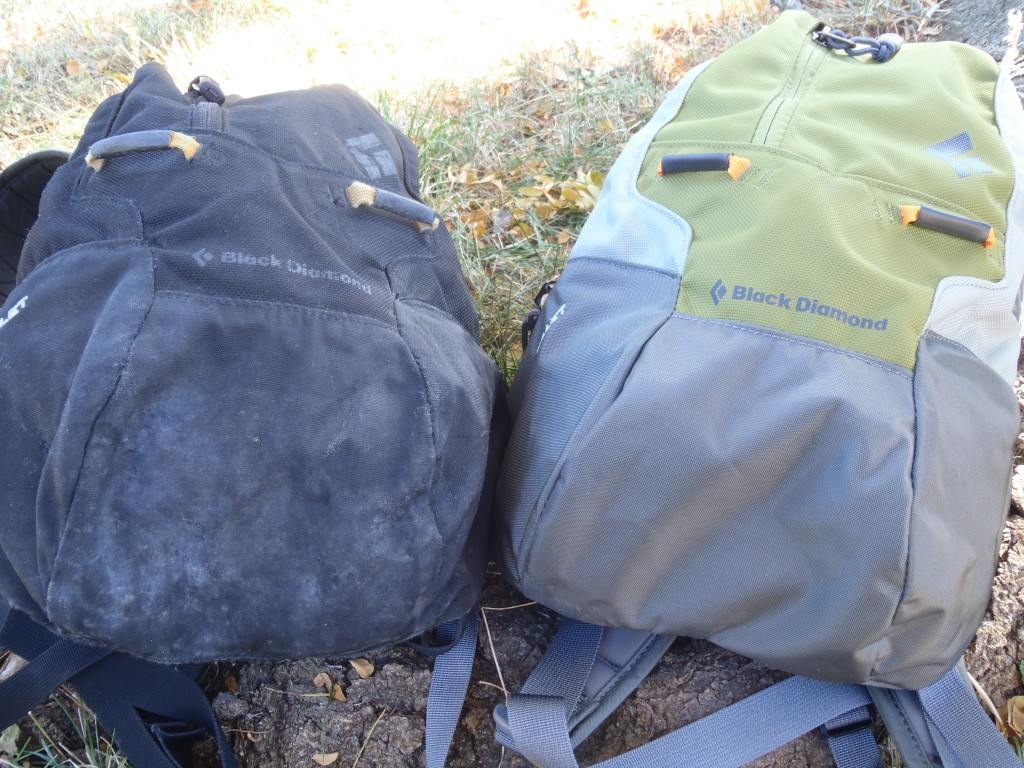
Packed Size
Scoring of each pack when rolled or stuffed as small as possible. On longer expedition-style trips it can be very useful to have a pack of this size for day trips and/or summit attempts. The REI Flash 18 is the most compressible and could easily be stored in the bottom of a larger pack, as could the Cilo Gear 20L Worksack (just slightly less compact). Packs with back padding don’t compress as small as those without padding and the Mountain Hardwear Crimper, with its extra-stiff padding, can hardly be packed down at all.
Comfort
Each pack was rated while loaded down with the minimum equipment you’d carry on a multi-pitch climb: a pair of sneakers, a liter of water, a bar, and a light layer. We wore each pack around town and put our body into every possible rock climbing position we could imagine. Comfort to us meant how flush the loaded pack sat against the back and how well it moved with us. How well the weight was distributed also mattered, and how protected we were against a nut tool or cam poking you us the back was important, too. The Bug scored highest with its sensible and modest back padding. The BBEE was a close second, with its padding just over the spine. The Shot scored the lowest since its padding seemed to restrict the pack from conforming to our back.
An explanation of the term “denier”
Denier is the unit of measure for the linear mass density of fibers. Silk is used as the standard for all comparison. A single strand of silk 9000 meters long weighs 1 gram, and is thus defined as having a denier of 1. Generally speaking, the higher the denier, the heavier and more durable the material.
The packs we reviewed used materials ranging from 70 denier (body of the Cilo Gear 20L worksack) to 1260 denier (bottom of the Black Diamond Bullet). Another distinction is the term ballistic, which signifies the use of a “basket-weave,” in which strands overlap and crisscross to create a thicker and tougher material. The Mountain Hardwear Crimper and the Black Diamond Shot use ballistic nylon throughout the pack, while the Black Diamond Bullet uses the ballistic material only in high-wear areas.


